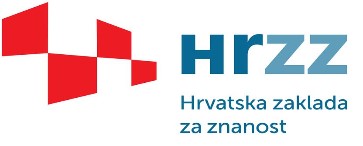Croatian Science Foundation

DeSPERADo: Depression, suicide and proteinopathy: elucidating the relationships between aggregation and pathological development
Project leaders: Prof. Nicholas J. Bradshaw (Rijeka), Dr. Katatina Kouter (Ljubljana)
Project associates: Bobana Samardžija (Rijeka), Maja Juković (Rijeka), Matea Kršanac (Rijeka), Prof. Rozi Andretić Waldowski (Rijeka), Aristea Pavešić Radonja (Rijeka), Ilijana Stanivuk (Rijeka), Andrea Montan (Rijeka), Simone Bernobić (Rijeka), Mohammad S. Hossain (Rijeka), Lora Polašek (Rijeka), Barbara Marinčić (Rijeka), Nina Kolđeraj (Rijeka), Prof. Alja Videtič Paska (Ljubljana), Iris Šalamon Arčan (Ljubljana), Julija Šmon (Ljubljana), Taja Bedene (Ljubljana), Mojca Katrašnik (Ljubljana), Prof. Tomaž Zupanc (Ljubljana)
Duration: 12/2023-12/2027
Funder: Croatian Science Foundation (Hrvatska zaklada za znanost, HRZZ) and the Slovenia Research & Innovation Agency Agency (ARIS) through the WEAVE Initiative, project grant IP-2022-10-2745
Major depressive disorder (MDD) is the most common form of disability occuring today, and can affect a patient, along with those around them, throughout their life. Suicide, meanwhile, is is the leading cause of violent death worldwide. Despite their importance, the biology underlying MDD and suicidal tendancy remains poorly understood, with genetic research showing both of these conditions to be highly complicated. In recent years, we have been investigating a novel approach to studying MDD, and related disorders, by investigating the role of proteostasis in its development. This approach has led to the identification of several proteins that aggregate in the brains of some MDD patients. Interestingly many of these proteins also form aggregates in victims of suicide. This project therefore aims to investigate the role of protein aggregation in MDD and suicidal tendency, combinding the expertise at studying protein aggregation in mental illness of the Rijeka group, with the expertise at studying the genetics of suicidal tendency of the Ljubljana group.
The major objectives of our project are:
- To identify and characterise proteins that aggregate in MDD and suicide.
- To investigate a protein known to aggregate in mental illness, TRIOBP-1, and determine the mechanisms underlying its aggregation.
- To understand the roles of endosomes and exosomes at transferring protein aggregates in these conditions.
- To understand whether aggregation of such proteins is consistent across the brain
- To determine if differences in epigenetic regulation of genes encoding aggregated proteins vary in victims of suicide
- To determine if differences expression of genes encoding aggregated proteins vary in victims of suicide
- To determine if rare variants of genes encoding aggregated proteins occur in victims of suicide
Beti Zaharija, Bobana Samardžija and Matea Kršanac are being supported by a PhD student stipends from the HRZZ: DOK-2018-09-5395 (2019-2025), DOK-2020-01-8580 (2020-2025) and DOK-NPOO-2023-10-6409 (2024-2030)
Previous project
CANDiD: Characterisation of aggregating proteins in neuropsychiatric diseases, including Drosophila models” (2023-2027). Project leader: Dr. Nicholas Bradshaw, PhD. IP-2018-01-9424
In this project, we began our detailed investigation of proteins aggregating in major mental illness in an interdisciplinary approach. Clinical work, in cooperation with the Psychiatry Department of the Clinical Hospital Centre Rijeka and the Semmelweis University in Budapest), allowed us to identifying aggregating proteins in brain and blood samples of patients. Cell culture investigations let us uncover aggregation critical regions in proteins that aggregate in mental illness, as well as determining the extent to which they “co-aggregate” with each other. Finally, work in Drosophila fruit flies allowed us to investigate the effects of these aggregates on behaviour
Major publications arising from this project to date are:
- Zaharija, Samardžija & Bradshaw 2020,
- Samardžija, Pavešić Radonja et al 2021,
- Zaharija, Odorčić et al. 2022,
- Zaharija & Bradshaw 2023,
- Samardžija, Juković et al 2023,
- Pavešić Radonja et al 2023
- Samardžija et al 2024
More details can be found on the Publications page.

DISC1: Its Structure, Causes of Aggregation and Relevance to Disease (the DISCARD collaboration)
Project leaders: Dr. Nicholas Bradshaw, PhD and Dr. Oliver Weiergräber, PhD
Project associates: Dr. Abhishek Cukkemane PhD, Beti Zaharija, MSc, Bobana Samardžija, Priyanka Sathyamoorthy MSc
Duration: 02/2022-01/2025
Funder: Alexander von Humboldt Foundation/Stiftung
Chronic mental illnesses, such as schizophrenia and major depressive disorder, are debilitating conditions, whose pathological basis is complex and still poorly understood. One protein of significant interest in studying these is Disrupted in Schizophrenia 1 (DISC1), a scaffolding protein involved in neurodevelopment, which is not only implicated through genetic evidence, but has also been shown to form misfolded protein aggregates in the brains of patients. These aggregates may be analogous to similar events in neurodegenerative conditions, such as Parkinson's disease or ALS.
The three-dimensional structure of the DISC1 protein is poorly understood and has proven very difficult to study. A breakthrough was made recently, however, by using a high throughput approach to map four putative folded domains within the protein.
In this project, a collaboration between researchers at the University of Rijeka (Croatia) and the Forschungszentrum Jülich (Germany), we aim to analyse both the structure of the DISC1 protein and the process by which it forms aggregates, using an interdisciplinary approach. At the University of Rijeka (Croatia), we are using molecular and cellular biology approaches to confirm and refine the domain structure of DISC1 in mammalian cells, as well as study the cellular consequences of its aggregation, through the expression of fragments of DISC1 in mammalian cells. Our partners in Jülich (Germany), meanwhile, are probing the structure and aggregation dynamics of the same fragments using biophysical and structural biology approaches in vitro. This is facilitated using a shared plasmid cloning program, as well as reciprocal research visits to coordinate approaches and share skills, including three extended visits by doctoral students. Both parts of the work are helped through regular online collaboration, and regular exchange visits by members of both laboratories to their partners abroad.
In this way, we aim to understand not only the structure of the DISC1 protein, but also how this structure goes wrong in mental illness, leading to the eventual onset of clinical symptoms.

The Bradshaw group has also recently won a bilateral project from the Ministry of Science, Education & Youth (MZOM) for travel to support collaborative research with Prof Alja Videtič Paska from the University of Ljubljana. Together, we will investigate protein aggregates as potential biomarkers for suicidal tendency.

Our group has received two grants from the University of Rijeka to support our work (young researcher’s grant 969, stimulation funding 1157). Previous funding to Dr. Bradshaw has come from the Fritz Thyssen Foundation, the Alexander von Humboldt Foundation and the Heinrich Heine University Düsseldorf.
